Ci sono stati momenti in cui tutto sembrava a posto in WordPress, ma il link del post mostrava un errore 404. Nessuna modifica al contenuto, solo una pagina mancante che avrebbe dovuto esserci.
Questo di solito compare dopo aver modificato le impostazioni, cambiato tema o aggiunto codice che influisce silenziosamente sui permalink. Può coglierti di sorpresa, soprattutto se il resto del tuo sito funziona perfettamente.
Ogni volta che ci imbattiamo in errori 404 inaspettati, seguiamo un semplice processo per ripristinare gli URL dei post, senza congetture o complicate risoluzioni dei problemi. Ed è esattamente quello che condividiamo con te in questa guida.
Sarai in grado di correggere gli errori 404 e assicurarti che i tuoi post vengano caricati come dovrebbero.

Perché i miei post di WordPress restituiscono un errore 404?
Ci sono diverse ragioni per cui i tuoi post potrebbero mostrare un errore 404 "Pagina non trovata" in WordPress. Queste possono includere:
- Conflitti tra plugin o temi: A volte, i plugin o i temi che hai installato sul tuo sito possono interferire con il modo in cui WordPress gestisce i permalink. Questo può portare a link interrotti ed errori 404.
- Problemi con codice personalizzato: Se hai aggiunto codice personalizzato al tuo sito web, potrebbero esserci errori nel codice che influiscono sui permalink o causano altri conflitti, con conseguenti errori 404 per i tuoi post.
- Problemi con il tuo file .htaccess: Il file .htaccess svolge un ruolo nel modo in cui WordPress struttura gli URL. Se questo file è corrotto o mancante, può causare errori 404 per i tuoi post o pagine.
Come trovare tutti i post di WordPress con errori 404
Prima di passare alle soluzioni, sarebbe utile capire se questo errore si verifica solo per uno o due post o per più post. In questo modo, puoi determinare l'entità del problema e scegliere la soluzione più appropriata.
Un modo semplice per scoprirlo è utilizzare Google Search Console. Se non hai ancora inviato il tuo sito a Google Search Console, leggi la nostra guida su come aggiungere il tuo sito WordPress a Google Search Console.
Una volta che il bot di Google ha scansionato e indicizzato il tuo sito, Google Search Console ti fornirà informazioni dettagliate sulle prestazioni del tuo sito, inclusi eventuali errori 404 che incontra.
Per scoprire quali post restituiscono errori 404, puoi accedere alla dashboard di Search Console. Quindi, naviga nel report 'Pagine' e vedrai un elenco dettagliato di tutti gli errori.
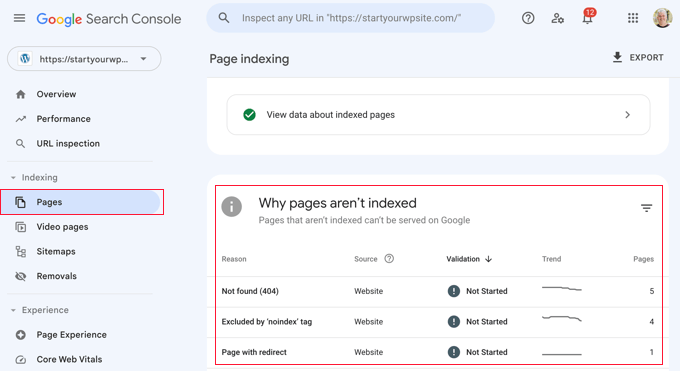
Per ulteriori informazioni, puoi leggere il nostro elenco di suggerimenti per l'utilizzo di Google Search Console per aumentare il traffico del sito web, che include alcuni suggerimenti su come correggere gli errori 404 con lo strumento.
Detto questo, vediamo come correggere i post di WordPress che restituiscono errori 404. Puoi utilizzare i link sottostanti per passare direttamente a diverse soluzioni:
- Metodo 1: Verifica conflitti di plugin o temi e problemi di codice personalizzato
- Metodo 2: Correggi le impostazioni dei tuoi Permalink
- Metodo 3: Aggiorna il file .htaccess di WordPress
- Metodo 4: Contatta il tuo provider di hosting
- Method 5: Enable mod-rewrite (Local WordPress Installation)
- Domande frequenti sugli errori 404 di WordPress
- 🎁 Bonus: Guida aggiuntiva sulla gestione degli errori 404
Metodo 1: Verifica conflitti di plugin o temi e problemi di codice personalizzato
A volte, plugin, temi o codice personalizzato che hai aggiunto al tuo sito web WordPress possono interferire con i permalink o causare conflitti, portando a errori 404. L'abbiamo sperimentato anche noi stessi quando testiamo strumenti sul nostro sito demo.
Un modo per risolvere questo problema è disattivare temporaneamente i plugin. I plugin a volte possono interrompere il modo in cui WordPress gestisce i link.
Una volta disattivati i plugin, puoi riattivarli uno per uno controllando se l'errore 404 ricompare dopo aver attivato ciascun plugin. Se l'errore si presenta dopo aver attivato un plugin specifico, quello potrebbe essere il colpevole.
Puoi quindi effettuare una rapida ricerca su Google per trovare soluzioni relative a quel plugin o contattare lo sviluppatore del plugin per assistenza.
Allo stesso modo, il tuo tema WordPress potrebbe causare il conflitto.
Per verificarlo, puoi passare temporaneamente a un tema WordPress predefinito come Twenty Twenty-Three o Twenty Twenty-Four. Tutto ciò che devi fare è andare su Aspetto » Temi e fare clic su 'Attiva' su un tema predefinito.

Se l'errore 404 scompare con il tema predefinito, ciò indica un potenziale conflitto con il tuo tema attuale. Puoi quindi provare a risolvere i problemi del tema o considerare l'utilizzo di un tema diverso.
Puoi consultare la nostra selezione di esperti dei temi WordPress più popolari per raccomandazioni.
Se hai recentemente inserito snippet di codice sul tuo sito web, potrebbero esserci errori nel codice che causano gli errori 404. Dai un'occhiata attenta al codice che hai aggiunto e vedi se riesci a identificare eventuali errori.
Il modo più sicuro per aggiungere snippet di codice a WordPress è con il plugin WPCode. Questo plugin ti consente di inserire codice personalizzato senza lavorare direttamente con i file del tema, riducendo il rischio di compromettere il tuo sito web.
Inoltre, ogni volta che WPCode rileva un errore nel tuo codice, disattiverà automaticamente lo snippet e ti chiederà di controllarlo. Puoi anche utilizzare la modalità di test per verificare se il tuo codice funziona prima di pubblicarlo sul tuo sito web live.

Se nessuna di queste soluzioni funziona, passa al metodo successivo in cui risolveremo i problemi relativi alle impostazioni dei tuoi permalink.
Metodo 2: Correggi le impostazioni dei tuoi Permalink
I post di WordPress possono restituire errori 404 a causa di problemi con le regole di riscrittura nel tuo file .htaccess. Nella maggior parte dei casi, puoi risolvere il problema aggiornando le impostazioni dei tuoi permalink.
Vai semplicemente su Impostazioni » Permalink nella tua bacheca di WordPress e fai clic sul pulsante 'Salva modifiche'.

Non è necessario apportare modifiche alle impostazioni dei permalink stesse. Questo aggiornerà le tue impostazioni dei permalink e svuoterà le regole di riscrittura.
Nella maggior parte dei casi, questa soluzione risolve l'errore 404 dei post di WordPress. Tuttavia, se non funziona per te, probabilmente dovrai aggiornare manualmente il tuo file .htaccess.
Metodo 3: Aggiorna il file .htaccess di WordPress
Prima di iniziare, assicurati di eseguire il backup del tuo file .htaccess di WordPress. Se qualcosa va storto, puoi facilmente ripristinare il file originale.
Ora dovrai connetterti al tuo server utilizzando un client FTP come FileZilla o il File Manager nel tuo pannello di controllo di hosting.
Successivamente, trova il file .htaccess nella cartella principale del tuo sito: questa è la stessa directory che contiene cartelle come /wp-content/ e /wp-includes/.
Fai clic destro sul file e seleziona 'Permessi file' o 'Cambia permessi' dal tuo client FTP.
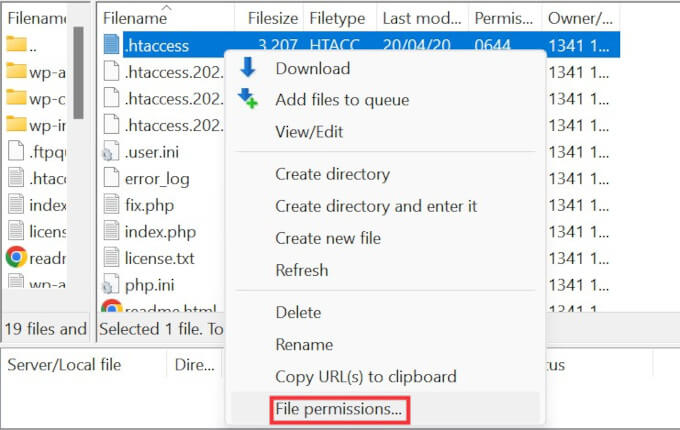
Se WordPress non è riuscito a scrivere sul file in precedenza, prova a cambiare temporaneamente i suoi permessi a 666 per renderlo scrivibile.
Dopodiché, torna all'area di amministrazione di WordPress e salva nuovamente le impostazioni dei tuoi permalink. Questo consente a WordPress di rigenerare un file .htaccess corretto.
Una volta fatto, assicurati di reimpostare i permessi del file a un'impostazione più sicura: 644. Questa impostazione consente a WordPress di leggere il file, proteggendolo comunque da modifiche non autorizzate.

In alternativa, puoi modificare manualmente il file.
Fai semplicemente clic destro sul file .htaccess e quindi seleziona l'opzione Visualizza/Modifica.
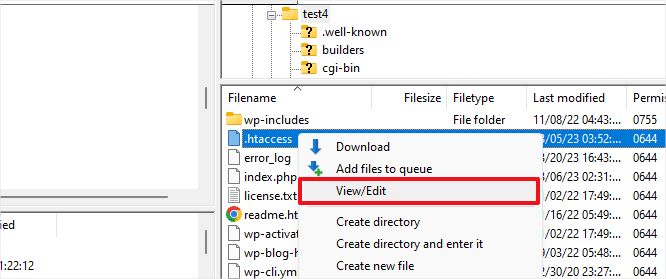
Il file si aprirà in un editor di testo semplice come Blocco note o TextEdit.
Ora devi aggiungere le seguenti regole di riscrittura predefinite di WordPress:
# BEGIN WordPress
<IfModule mod_rewrite.c>
RewriteEngine On
RewriteBase /
RewriteRule ^index\.php$ - [L]
RewriteCond %{REQUEST_FILENAME} !-f
RewriteCond %{REQUEST_FILENAME} !-d
RewriteRule . /index.php [L]
</IfModule>
# END WordPress
Metodo 4: Contatta il tuo provider di hosting
Se nessuna delle soluzioni sopra ha risolto l'errore 404 dei post di WordPress, ti consigliamo di contattare il tuo provider di hosting WordPress. Potrebbe esserci un errore da parte loro o potrebbero essere in grado di aiutarti a risolvere il problema.
Consulta anche la nostra guida su come chiedere correttamente supporto per WordPress e ottenerlo.
Metodo 5: Abilita mod-rewrite (Installazione WordPress locale)
Se stai utilizzando un server locale per scopi di test, dovrai abilitare mod_rewrite nella configurazione Apache del tuo sito MAMP, WAMP o XAMPP.
Questo consentirà a WordPress di generare URL puliti e prevenire l'errore 404 per post e pagine sul tuo server locale.
Il modo in cui lo farai differirà a seconda della piattaforma che utilizzi. Le persone che usano XAMPP possono aprire il loro pannello di controllo e fare clic sul pulsante 'Config' in Azioni. Quindi, seleziona 'Apache (httpd.conf)'.
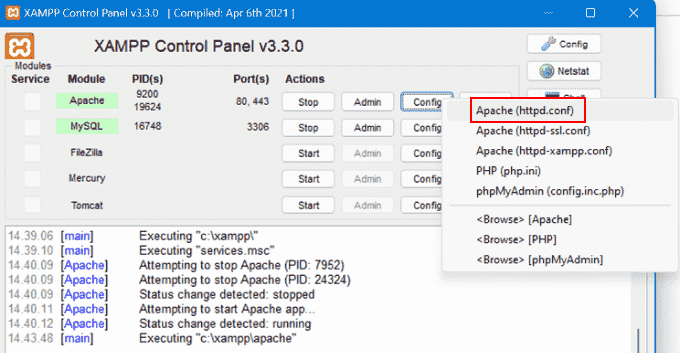
Successivamente, dovrai trovare questa riga #LoadModule rewrite_module modules/mod_rewrite.so e rimuovere il '#' per decommentarla.
Questo caricherà il mod_rewrite.
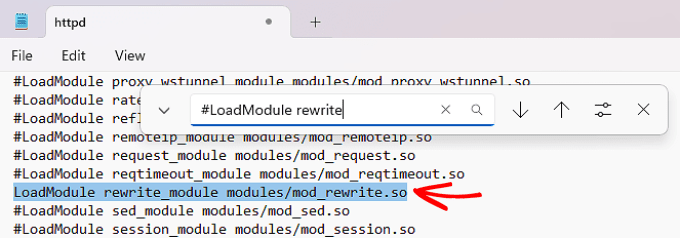
Quindi, cerca le righe che dicono AllowOverride None e cambiale in AllowOverride All. Questo dice ad Apache di consentire l'uso dei file .htaccess.
Di solito li trovi all'interno dei blocchi <Directory>, specialmente quello che punta alla cartella del tuo sito, come htdocs se stai usando XAMPP. Se non sei sicuro, va bene applicare la modifica ovunque la vedi all'interno del file, purché non si tratti di una directory di sistema. Per il testing locale, questo di solito funziona benissimo.

Una volta fatto, puoi salvare il file httpd.conf e chiuderlo. Successivamente, nel pannello di controllo di XAMPP, fai clic su 'Stop' sul modulo Apache e di nuovo su 'Start' per riavviarlo.
Quindi, torna alla tua bacheca di amministrazione per vedere se i tuoi permalink funzionano.
Tutorial video
Se hai bisogno di istruzioni visive, guarda il video qui sotto.
Domande frequenti sugli errori 404 di WordPress
Incontrare errori 404 sul tuo sito WordPress può essere fonte di confusione. Di seguito, abbiamo risposto a domande comuni che possono aiutarti a risolvere e correggere il problema in modo più efficace.
1. Perché ricevo un errore 404 sui miei post di WordPress?
Questo di solito significa che WordPress non riesce a trovare il post all'URL richiesto. Può accadere a causa di permalink interrotti, un file .htaccess corrotto, post eliminati o un conflitto di plugin/tema che modifica la gestione degli URL.
2. Come risolvo un errore 404 in WordPress?
Prova a salvare nuovamente le impostazioni dei tuoi permalink andando su Impostazioni » Permalink e facendo clic su 'Salva modifiche'. Se ciò non funziona, controlla il tuo file .htaccess, disabilita i plugin o passa a un tema predefinito per escludere conflitti.
3. Come posso trovare tutti gli errori 404 sul mio sito WordPress?
Puoi utilizzare Google Search Console per vedere un elenco di errori 404 che Googlebot incontra. Plugin come Broken Link Checker possono anche aiutare a individuare link interrotti e pagine mancanti all'interno del tuo sito.
4. Cosa fa il file .htaccess in WordPress?
Il file .htaccess controlla come vengono elaborati gli URL. WordPress lo utilizza per gestire la struttura dei permalink e instradare gli URL al contenuto corretto. Se è mancante o corrotto, gli URL potrebbero smettere di funzionare correttamente.
5. Come modifico in sicurezza il file .htaccess?
Puoi modificarlo usando un client FTP o il file manager del tuo hosting. Esegui sempre un backup prima. Dopo la modifica, assicurati che i permessi siano impostati su 644 in modo che rimanga leggibile e sicuro.
6. Perché le mie pagine di categoria o tag di WordPress mostrano errori 404?
Questo può accadere se il tuo tema non supporta i modelli di archivio o se le impostazioni dei permalink sono configurate in modo errato. Salvare nuovamente i permalink e verificare il supporto dell'archivio del tuo tema può aiutare a risolvere il problema.
7. Come posso correggere gli errori 404 per i tipi di post personalizzati?
Visita Impostazioni » Permalink e fai clic su 'Salva modifiche' per aggiornare le regole di riscrittura. Inoltre, verifica che il tuo tipo di post personalizzato sia registrato con le giuste impostazioni di riscrittura e abbia il supporto dell'archivio, se necessario.
8. Posso reindirizzare le pagine 404 alla mia homepage o a un'altra pagina?
Sì, plugin come Redirection ti consentono di creare reindirizzamenti 301 da URL vecchi o non funzionanti a quelli nuovi. Puoi anche creare una pagina 404 personalizzata per guidare gli utenti verso contenuti utili.
🎁 Bonus: Guida aggiuntiva sulla gestione degli errori 404
Potresti trovare utili anche le seguenti risorse per la gestione degli errori 404 e altri errori comuni di WordPress.
- Come migliorare il tuo template di pagina 404 in WordPress (2 modi)
- I migliori esempi di design di pagine di errore 404 per WordPress
- I migliori plugin gratuiti per reindirizzare gli errori 404 per WordPress
- Come ricevere avvisi via email per errori 404 in WordPress
Speriamo che questo articolo ti abbia aiutato a risolvere i post che restituiscono errori 404 in WordPress. Potresti anche voler consultare la nostra guida agli errori WordPress più comuni e come risolverli, insieme alle nostre scelte esperte per i migliori plugin WordPress per far crescere il tuo sito.
Se ti è piaciuto questo articolo, iscriviti al nostro canale YouTube per tutorial video su WordPress. Puoi anche trovarci su Twitter e Facebook.





Assoluto
Aiuta.. solo sul permalink, ha già risolto il mio errore..
Grazie per questo articolo..
Julius
Il mio è un po' diverso. Tutte le pagine funzionano bene ma ottengo "pagina non trovata" quando lavoro in alcuni punti della dashboard. Diciamo, ad esempio, che sto creando una nuova pagina dalla dashboard. Quando clicco su pubblica ottengo un errore 404.
E ho provato tutto quello che c'è sopra ma non funziona.
Iron65
Grazie per il suggerimento!! il permalink mi ha davvero salvato!!! Nel caso in cui qualcun altro abbia sofferto questo problema aggiornando Yoast SEO o semplicemente cancellando la cache, provate quello, risolverà
Monica
Ho cercato di risolvere questo problema dei permalink sul mio sito per mesi e ora l'ho fatto con le tue istruzioni. Non so perché ho già fatto tutto quello che hai detto e dopo aver scritto i permessi 644 per correggere il file httaccess, è tornato non scrivibile. Ora l'ho fatto e ho corretto i permessi e ho scritto il tuo codice e ha funzionato. Non so davvero quale sia stata la differenza, ma questa volta ha funzionato. Forse ho già corretto l'htaccess nella cartella originale dove ho una sottocartella con il mio blog. Quell'unica cosa che ho fatto diversamente. Grazie mille
Rais Dar
Sto ricevendo un 404 (pagina non trovata) sul mio sito. Cosa dovrei fare dato che ho provato i tuoi metodi ma l'errore persiste
Chetan
Ho affrontato lo stesso tipo di problema. Ricevevo un errore 404 Pagina Non Trovata per una pagina. Ma il motivo era che avevo usato uno slug di permalink associato ad alcune pagine predefinite in WordPress. Ad esempio: http://example.com/posts – Questo è SBAGLIATO. Perché non posso usare 'posts' come slug di permalink. È già riservato per alcune pagine di WordPress. Quando l'ho cambiato in 'my-posts', in modo che ora il mio permalink leggesse: http://example.com/my-posts, l'errore è scomparso!
md
ciao, ho lo stesso htaccess., tuttavia, l'ho cancellato e ne ho importato uno nuovo ma è ancora lo stesso.
stupido
ciao ragazzi.... quando cambio il permalink in qualcosa di diverso dal predefinito, le mie pagine non funzionano e ricevo questo messaggio di errore "L'URL richiesto /wordpress/home/ non è stato trovato su questo server."
Apache/2.4.9 (Win64) PHP/5.5.12 Server at localhost Port 80"
per favore aiutami
Ian Scofield
Ho appena avuto questo problema con uno dei miei siti web. Tutti i miei post funzionavano bene tranne uno. C'era qualcosa di sbagliato nell'URL. Ho dovuto cambiare l'URL del post.
neelesh
Grazie mille… il tuo sito mi ha aiutato molte volte e voi ragazzi state facendo un ottimo lavoro. Non posso resistere dal ringraziarvi…..
Hardik
Ciao Wpbeginner,
In realtà sono appena migrato da Hostinger a un hosting a pagamento. Dopo la migrazione, tutto procede bene. Ma quando ho provato a modificare uno dei miei post, compare regolarmente il seguente errore.
“Errore pagina non trovata” ‘Ci scusiamo, ma la pagina richiesta non è stata trovata. Forse la ricerca aiuterà.
Quando sono arrivato qui, ho provato tutte le soluzioni che hai condiviso.
Ma niente sta funzionando per me.
Per favore, aiutami.
Grazie in anticipo
Hardik
Adrienne
Domanda? Ho un sito con un URL, ma i dati sono tutti nuovi. quindi ci sono circa 100 vecchi post che non sono più validi ma collegati ad altri siti. Come faccio a reindirizzarli al sito principale, in modo che Google Search Console possa aggiornare i suoi record di scansione.
Sto cercando, ma non vedo nulla per i post che sono stati eliminati e che restituiscono un errore 404.
Grazie,
David
Grazie, stavo avendo esattamente quel problema e questo lo ha risolto perfettamente!
Mark
Grazie! È così bello trovare una soluzione così facile per un problema così frustrante e misterioso.
Xavier
Woohoo! Grazie per questo. Pensavo che il contenuto del mio sito fosse andato a farsi benedire. Fare clic su "Salva modifiche" nei permalink ha funzionato istantaneamente per me.
Pablo
E se non funziona, non importa cosa fai?
AIUTO!
Fida
Ciao Pablo, quale server usi? Server condiviso o VPS?
Steve Jackson
Grazie per questo consiglio, è stato un salvavita e ha funzionato perfettamente!
John
Grazie !!!!
abhishek
grazie mille ha salvato i miei link abbastanza bene
Hugo Nascimento
Ciao ragazzi,
Ho lo stesso problema con il blog di un cliente. Sto cercando di creare un modulo personalizzato all'interno della pagina del post e quando abilito i permalink personalizzati, il modulo non è accessibile.
Quando cambio i permalink in predefiniti, funziona! :/
Davvero strano. :/
Sarah
Cambiare i permalink in predefiniti ha risolto anche il mio problema! Grazie!
mojamalenkost
Grazie mille!!!
victor
Ho questo problema. Non riesco ad accedere alla mia bacheca di WordPress, ogni volta che ci provo mi dà Errore 404 non trovato. Per favore, aiutami a risolvere questo.
Non chiedere il vero nome
Il tuo consiglio mi ha salvato la vita. Tutti i nostri post semplicemente non erano visibili. Il tuo consiglio ha aiutato molto.
Quello che ho fatto:
Aggiornato .htaccess impostato CHMOD a 666 invece di 660
Cliccato su -> Impostazioni -> Permalink
Cliccato su Predefiniti e cliccato su Salva modifiche
Di nuovo,
Cliccato su Nome del post e cliccato su Salva modifiche. (dato che usavo URL personalizzati)
Mi hai risparmiato un sacco di mal di testa...
Clive Wales
È stato un vero salvavita – pensavo di aver completamente rovinato un sito di sostituzione su cui stavo lavorando, dopo aver cercato di essere furbo con una reindirizzamento .htaccess. Grazie!
Marko Liuksiala
Ottimo, ha funzionato – grazie!!
Bill
Mi piace la struttura dei permalink dei miei post e sembrano funzionare. Uso la stessa struttura da diversi anni.
Tuttavia, quando vado su Impostazioni–>Permalink, la struttura effettiva non è nemmeno elencata tra le opzioni disponibili.
È un problema?
Emily
Ciao, ho questo problema e, ad essere sincero, mi sento male perché non so cosa fare. Sono davvero un principiante e ho paura di rovinare il mio sito web più di quanto non abbia già fatto.
Qualcuno può dirmi come dovrebbe apparire il mio permalink personalizzato e cosa DOVREI avere nel mio file .htaacess? Al momento sembra vuoto?
Supporto WPBeginner
Vai su Impostazioni » Permalink, scegli una struttura di permalink che ti piace e poi salva le modifiche. Apri il tuo file .htaccess e noterai che WordPress lo ha aggiornato automaticamente. Se è vuoto e la struttura di permalink scelta non funziona, puoi aggiungere manualmente questo codice nel tuo file .htaccess:
# BEGIN WordPress
RewriteEngine On
RewriteBase /
RewriteRule ^index\.php$ – [L]
RewriteCond %{REQUEST_FILENAME} !-f
RewriteCond %{REQUEST_FILENAME} !-d
RewriteRule . /index.php [L]
# END WordPress
Amministratore
Viktor
Sì, quella era la soluzione! Grazie mille. Il mio servizio di hosting ha modificato queste impostazioni quando ho cambiato l'URL per le pagine di errore personalizzate, ma è bastato cliccare sulle impostazioni dei permalink per risolvere.
Matthew Shelton
“Vai su Impostazioni » Permalink, e clicca semplicemente sul pulsante Salva modifiche” – fantastico, ha funzionato subito – grazie mille!!
Staff di WPBeginner
Controlla il file .htaccess.
Gretchen Louise
E per quanto riguarda un singolo permalink di un post che è stato modificato e ha creato un reindirizzamento interno, e ora non può più essere modificato senza creare un errore 404? Sto cercando di risolvere un problema per un cliente e mi chiedo dove siano memorizzati questi reindirizzamenti interni e dove nel mondo si possano cancellare. Grazie.
Thembi Ngema
Dudessss. You guys are legends :)…. Must say I have learnt a lot from you in the past week
bhupendra
ciao
grazie ho appena aggiornato la struttura dei parmalinks e il sito ha iniziato a funzionare
Arpee Lazaro
ho appena aggiornato le strutture dei permalink come mostrato in questa soluzione e ha funzionato alla grande. grazie!
Staff di WPBeginner
Contatta il tuo web host.
Attiq Haroon
Ho provato le soluzioni che hai menzionato nel tuo post ma non sembrava funzionare. Quello che è successo in realtà è che volevo aggiungere una regola al file .htaccess, quindi ho scaricato quei file da FTP, li ho modificati e ho caricato di nuovo il file sostituendo quello originale, e poi è sorto il problema. Ho provato un paio di soluzioni come eliminare e inserire un nuovo .htaccess con il codice predefinito, rimuovere il file .htaccess, ecc. L'unica soluzione che rende i post accessibili è impostare il permalink all'opzione predefinita. Questo fa funzionare i post ma non può essere una soluzione permanente in quanto non è raccomandato dal punto di vista SEO
Per favore, prova a trovare una soluzione funzionante per quel problema
Staff di WPBeginner
Esegui il backup del tuo file .htaccess. Quindi elimina quello dal tuo server. Ora accedi all'area di amministrazione di WordPress e vai su Impostazioni -> Permalink, scegli la struttura dei permalink desiderata e fai clic su Salva modifiche.
Successivamente, connettiti via FTP e verifica se WordPress ha creato un nuovo file .htaccess e se non è vuoto.
Attiq Haroon
Ho provato quella soluzione, ha creato un file .htaccess che sembra a posto ma non funziona.
gui
Se hai installato Yoast WordPress SEO o qualsiasi plugin SEO, controlla la sezione permalink SEO...
Tim Topham
Ciao ragazzi – Ho recentemente ricevuto un'email da Google crawl poiché improvvisamente avevo più di 500 link persi. Sembra che a un certo punto io debba aver cambiato la struttura dei permalink in modo che molti dei link nei vecchi post abbiano la data del post e poi il nome del post, mentre ora hanno solo il nome del post.
Prima di impazzire cercando di correggere manualmente 500 link nei miei articoli, c'è un modo semplice per aggiornare gli hyperlink negli articoli quando succede una cosa del genere?
Saluti,
Tim.
Manuel Moreira
Stavo impazzendo con questa cosa del 404 dopo uno spostamento del server. Grazie per l'aiuto ragazzi.
Cindy
grazie! I miei siti sono stati hackerati e tutte le pagine interne mostravano un errore 404. Salvare le impostazioni dei permalink lo ha risolto! Saluti!
Joe Cutroni
Ciao a tutti, ho setacciato il web per trovare aiuto per risolvere il mio problema, ma
per quanto mi sforzi non riesco a far funzionare nulla. Solo un paio di
settimane fa, tutte le mie pagine del back-end (la home page andava bene) hanno iniziato a
restituire errori 404.
Il permalink che ho sempre usato è "Struttura personalizzata" (/%category%/%postname%/)…ecco alcune cose che ho provato:
1. Sono andato nei miei permalink, ho cliccato su "salva impostazioni", e questo metodo fornisce una soluzione temporanea, forse per un'ora o due, poi gli errori 404 ritornano su tutte le pagine secondarie. Ho anche impostato i miei permalink su un'opzione diversa, come "Predefinito", ma ottengo comunque errori 404 poco dopo.
2. Ho cancellato completamente il mio file htaccess.php, poi sono tornato indietro e ho salvato le impostazioni dei permalink…meno di un'ora dopo, gli errori 404 sono ritornati.
3. Ho commentato questa riga di codice nel mio file function.php, e l'ho anche rimossa del tutto:
“$wp_rewrite->flush_rules();”. Non ha fatto nulla. Ho provato
a usare sia “//” che “#” prima e ho testato… continuo a ricevere errori 404.
4. Ho disattivato tutti i miei plugin per vedere se uno di loro fosse il colpevole,
ma dopo poco tempo, i miei errori 404 sono ripresi mentre nessuno dei plugin era attivo.
Come ho detto, questo problema è iniziato solo poche settimane fa. Uso Securi
Security e ho fatto scansionare il mio sito per malware, ecc… e il sito
è pulito.
Qualcuno può AIUTARMI per favore? Lo apprezzerei moltissimo!
Kyle
Ciao Joe,
Hai mai trovato una soluzione funzionante per questo? Ho riscontrato gli stessi problemi che hai elencato.
David
Ciao ragazzi!
Avete trovato una soluzione all'errore 404 ricorrente come elencato sopra da JOE CUTRONI?
Sto affrontando lo stesso problema?
Qualche feedback sarebbe fantastico!
Grazie!
Saluti dalla Germania,
David
Paul
Ciao ragazzi,
è probabile che tu abbia un virus sul tuo sito.
In bocca al lupo
Paul
Katie
Questo è il problema che sto riscontrando. Mi sono spostato da Wordpress.com a .org e sono al limite. Capisco le istruzioni che dicono vai su admin—> impostazioni —> permalink. Infatti, ricordo che quando stavo configurando questo, ho modificato quella particolare impostazione. Ecco i miei problemi: DOVE trovo questo admin–> impostazioni–> permalink?? È sul mio host, nel cpanel? È di nuovo su WP.com, o se è WP.org? E se è su WP.org non ho idea di come accedere a tutte le funzionalità di amministrazione del mio blog ora. Quando accedo, mi mostra il mio profilo personale e mi permette di modificarlo. Ma nessuna amministrazione del blog. Sono perso e sto davvero perdendo la testa.
Gabriel
Se ti ho capito bene, digita semplicemente il nome di dominio su cui hai attivato lo strumento wp.org e aggiungi "/wp-admin" (ad esempio "www.example.com/wp-admin") accedi e in basso a sinistra troverai l'opzione impostazioni.
mali suresh
come posso cambiare il parametro localhost passo dopo passo aiutami
Srihari K
Ho avuto lo stesso problema.. aggiungere la seguente riga in httpd.conf e riavviare apache ha risolto il problema.
Options +FollowSymLinks
Kym Penrose Clayton
Thank you thank you thank you
Iris Fritschi-Cussens
GRAZIE dal profondo del mio cuore! Ho dovuto eliminare il mio file .htaccess a causa di un hack e poi proprio quando pensavo che tutto fosse di nuovo a posto, niente funzionava tranne la home page. Premere Salva modifiche sui permalink lo ha risolto in un attimo.
disqus_Hct2NXneXJ
Grazie Uomo. La Soluzione Permalink ha Risolto il mio Problema. Grazie & Saluti a Te!
MEMEME
Grazie! Sei un Dio.
L
grazie! Ero vicino al panico...
Thai
Grazie per il post! Ma purtroppo ho provato queste soluzioni in locale e nessuna ha funzionato... Altri suggerimenti?
SemLavana
Thank you. Saved my weekend!